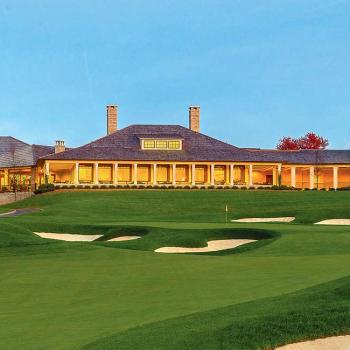In 1921, a few days prior to the British Open a golf competition was waged at Gleneagles, Scotland, between British professionals and American professionals. But its purpose was simply to help attract more American pros to come across the pond and play in the British Open.
For 1926, Samuel Ryder suggested a serious golf match between the best British professionals and the top American professionals who would sail the Atlantic Ocean to participate in the British Open. It was arranged and conducted that year at the new East Course at Wentworth near London. Mr. Ryder was delighted when his personal golf instructor Abe Mitchell teamed with George Duncan to defeat the defending British Open champion Jim Barnes and the great Walter Hagen. Afterwards, while hanging out with those boys at the bar and sipping a cool one, Sam Ryder announced, “We must do this again.”[1]
No wonder Ryder said that. The British team trounced the American team 13.5 points to 1.5 points. But half of the ten members of the American team were foreign-born players who nonetheless resided in the U.S. On this account, the competition immediately was declared unofficial. The following four things were then decided: (1) the matches would be resumed the next year, (2) all Americans had to be native-born, (3) the event would be a biennial affair, and (4) the venue for each competition would switch across the Atlantic Ocean to be hosted by that team.
Sam Ryder then offered to bear the expense of having a golden cup made which would be presented to the winner each year. It came to be called “the Ryder Cup.” Strangely, the earlier Ryder Trophy for the ministers’ one-day golf affair is made of silver and shaped as a cup, whereas the larger Ryder Cup is solid gold nineteen inches high and shaped as a trophy, with a figure of Mr. Ryder’s instructor, Abe Mitchell, on top of it addressing a ball with a club in hand.
So, the Ryder Cup competition between the best British and American professional golfers was born officially in 1927. (Pros from Ireland were later included with those from Great Britain.) The British team sailed the ocean blue to arrive in America and suffer a trashing by being defeated 11.5 points to 2.5 points at Worcester Country Club in Worcester, Massachusetts. (During my career on the regular Tour, we played a tournament at this club for many years.)
From 1927 to 1959, the Ryder Cup contest was a two-day match-play event involving both team and individual play. Winners of matches got one point. Halved matches had no playoffs, with ½ point going to each side. In 1963, the competition was expanded to three days, from Friday to Sunday, as it still is today. And nowadays, each team has twelve players instead of ten. The American pros consider the privilege of playing on the Ryder Cup team as a great honor in representing their country.
For a long time the Americans dominated the Ryder Cup, often winning by lopsided margins. Then Jack Nicklaus suggested that, to make the Ryder Cup matches more evenly competitive and thus more exciting for golf fans, the British squad should be expanded to include continental European players. That idea was inaugurated in 1979 and continues today, and it has helped the event to become immensely popular. So, nowadays, the Ryder Cup is between the USA and Europe. Since 1987, Europe has won the Ryder Cup nine times, and the U.S. has won it four times, with one year resulting in a tie. Other than the Olympics—which will reinstate golf from both the amateur and professional ranks in the 2016 Summer Olympics—there is really nothing quite to compare the Ryder Cup to in other sports.
Sam Ryder died in 1936 at age 77. His funeral was held at his Trinity Congregational Church in St. Albans. At the nearby Hatfield Road Cemetery, his coffin was buried in the dirt with his favorite five-iron, then called “a mashie.” No joke. Heh, Sam had swung that club many times trying to dig a little white ball out of the dirt. Why not bury it in there with him? Makes perfect sense to me. In the blessed resurrection for those called up yonder, maybe Sam Ryder will come up out of his grave just a swingin’ away.
Now, that makes me think of something. Recently, the USGA and the Royal and Ancient Golf Club agreed to ban the extra-long putter. I wonder if any golfer has died and been buried with one of those ghastly things. Tour caddies love to hate them because they weigh about three pounds. If so, what would the ruling be? Would that now, illegal club disqualify a golfer from squeezing through the Pearly Gates to play 18 holes at a truly serene scene—Heaven Country Club? May have to call Joe Dey to get a ruling on that one. Best to do like Sam Ryder and just use the mashie.
Samuel Ryder originally envisioned the Ryder Cup matches only as “a small friendly lunch party” with some golf mixed in. He surely never could have dreamed what it has become today—the greatest, pressure-packed golf competition in the world. And it was the brainchild of this successful businessman and devout Christian who only took up golf at age 50 to improve his health. Yet he became such a golf enthusiast and one of the best supporters of our beloved game.
Nothing creates international exposure to the game of golf like the Ryder Cup does. Of course, it is much aided by worldwide television. Such media exposure indirectly helps increase purses on the European Tour and in PGA TOUR tournaments, and it benefits club professionals.
The Samuel Ryder Foundation at St. Albans, England, says of Sam Ryder that it “aims to promote public knowledge and appreciation for the many things he achieved and the values he stood for.” Christ inside Samuel Ryder extended across the pond to greatly affect the PGA Tour from its very beginning to this very day.












